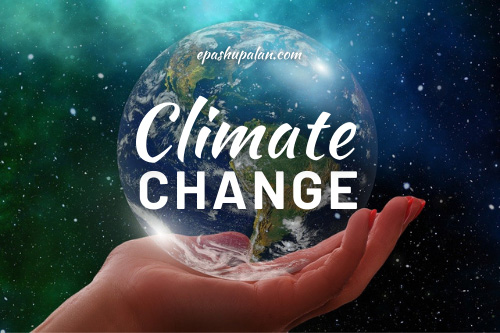Everything on this planet is interconnected, so if there is change in one thing, there will be alteration in everything else. The relationship between human beings, animals and environment is a delicate balance. As the world’s population has increased exponentially within last few decades, the industrialization is also increasing with the same pace and due to this the plants, animals, and environment is getting profoundly affected. The population growth and technological expansion has led to deforestation and pollution which are the major adverse effects causing global climate change. If the climate change will be continuous at same rate many creatures will come to the verge of extinction. Increasing temperature of earth due to industrialization has resulted in an increase in global warming. Major disasters like flood, drought, hue waves, forest fires etc. is the consequence of increasing global warming.
The average temperature of earth’s surface is about 15℃ which has increased by approximately 1.18℃ since last 19th century. This change is greatly driven due to increased CO2 emissions in atmosphere by industries and other human activities. The effect of global warming has largely increased in past 40 years and according to climatic data the years 2016 and 2020 were assumed to be the warmest years till now. Extreme weather and melting glaciers on the poles are the most devastating effects of CO2 emission which come from burning of fossil fuels in machines and vehicles.
Global warming is affecting the entire planet due to which several species are losing their habitats. According to some reports, over 70 different types of frogs have already become extinct, and many are at the verge of extinction. Animals like polar bears, penguins which are the natural inhabitant of polar regions are now desperately searching for the place at which they can comfortably survive. This is due to melting of polar ice glaciers due to global warming.

There are several reports from IUCN which shows that about 11 out of 17 species of penguins are facing the risk of extinction mainly the chicks are at more risk. This is because some species of penguins give birth to their chicks on the land locked sea ice but due to a drastic increment in temperature in the Antarctic, the sea ice is constantly going on melting and getting detached from the mainland. As the chicks does not have well developed waterproof feathers, they are very prone of being easily swept away in water thus leading to decrease in the population of penguins.
The temperature affects the animals as it can even determine their sex. Gender is decided at a crucial step of embryonic development by temperature in some reptiles so even a slight increase in temperature can lead to the development of entire female population in some reptiles like crocodiles. It can be beneficial to some extent but as it is well said that extremes of anything is harmful. So ultimately it will cause disastrous affects at the end. The changing climatic conditions are disrupting the migration patterns of birds as well as mammals, as a result their habitat is shrinking at an accelerated rate. Reproductive efficiency of animals mainly elephants, marsupials and some primates are decreasing due to which they are coming under vulnerable list. The productive livestock comes under extreme stress due to abruptly changing climatic conditions as a result there is severe decline in productivity which is causing scarcity of food products ultimately increasing the hunger ratio.
As the population is increasing the forests are being cut to fulfill the livelihood requirement. The trees majorly absorb CO2 from the atmosphere, converts it into O2 and purifies the environmental air but due to rapid deforestation the level of CO2 is continuously increasing on the planet which is eminently contributing to the increase in global temperature. The hot and humid climate is favorable for growth of many pathogenic microorganisms which are responsible for causing diseases in humans and animals. The alteration in land areas by deforestation for settlement of human beings, agriculture, infrastructure development etc. is causing catastrophic effect on animal habitat. As human activities are encroaching the boundaries of animal habitat, the buffer zone between human and animals is going on reducing which is ultimately leading to close proximity of humans and animals which is greatly responsible for spread of several zoonotic diseases resulting in losses of both human and animal health.
Before the climate change produces a more worst situation proper steps should be taken to diminish its hazardous effects due to global warming in near future. For this proper communication with wider public should be done regarding the threats of global warming and its deleterious effects on plants, animals, environment and ultimately on human beings themselves. There is an essential need to reduce carbon emissions from burning of fossil fuels. So, a little step of awareness can save million lives as well as natural biodiversity.
“DESTROY GLOBAL WARMING BEFORE IT DESTROY THE MOTHER NATURE”







Be the first to comment